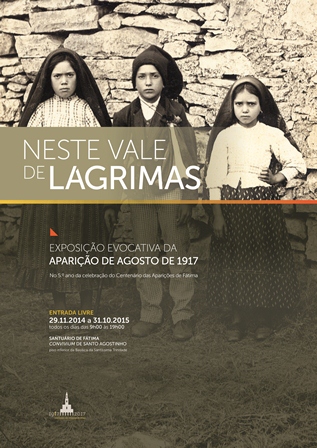29 november, 2014
 5th year of the centennial celebration of the Apparitions of Fatima Inaugurated on November 29, the exhibit will be open until October 15, 2015. In the year the Sanctuary of Fatima reflects, in a special way, on the fourth Marian apparition in the Cova da Iria, which, according to the testimony of the seers, occurred in August 1917, the exhibition "In this valley of tears", adopting as maxim the words of the hymn ‘Hail Holy Queen’ [Salve Regina], presents to visitors a reflection on the political and ideological context that marked the country and the world, during the second decade of the 20th century. Understanding the journey the three children of Aljustrel made to Ourém, in order to be interrogated, as a living metaphor of the events then taking place in Portugal and in the world, the visitor will find, at the core of the exhibition, a reflection on World War I and the First Republic. Both historical crises and circumstances set the stage of the Fatima apparitions; the first worldwide, the second at national scale. In the first part, entitled "And after this our exile ...", the pilgrim is led from the Cova da Iria to Aljustrel, to the place of Valinhos where, as stated by the seers, the August apparition took place. Before getting there, he will come into contact with two versions of the same journey, both regarding those days of August 1917, one told through the eyes of a believer, and the other as watched and commented by anticlerical newspapers parodying and deriding Fatima. Thus the visitor will have the possibility of becoming acquainted with objects that, along this episode situated between the 13th and the 19th of August, were touched and handled by Francisco, Jacinta and Lucia. This event, named by Lucia herself as “trip or imprisonment”, is the starting point of the explanative annotations that, in the second part, entitled “Mourning and weeping”, remember the great military conflicts of the 20th century (World War I, whose centennial of its beginning this exhibition also evokes, World War II and the Colonial War, i.e. an historical context particularly associated with the devout supplications deposited at the Sanctuary of Fatima by Portuguese people). Among the exhibition pieces some are prominent and conspicuous: “The Christ of the Trenches”, an army uniform of World War II, the sculpture of Clara Menéres “Jaz morto e arrefece o menino de sua mãe” [Lies dead and cools his mother’s son]; this last work, whose name alludes to a celebrated poem of Fernando Pessoa, is one of the most expressive aesthetic challenges to overseas war, even before it came to an end. Under this same title are also displayed the contents related to the ideological clash over the religious issue of the First Republic, which, in Fatima, had again a symbolic moment with the bombing of the Chapel of the Apparitions in 1922. In the third and final part of the exhibition, titled with the invocation traditionally used at the end of Salve Regina ("Pray for us, Holy Mother of God "), is proposed for consideration the way which, in accordance with the testimony of the seers, was indicated by the Virgin Mary to achieve peace: the recitation of the Rosary. Therefore, some Rosaries, from the collection of the Fatima Shrine Museum, integrate this exhibit as well; among them, it’s possible to see, for the first time, the Rosary offered to Our Lady of Fatima by Pope Francis, in October 2013, and the Rosary presented by Caxinas fishermen after the 2012 shipwreck. The pieces in the presentation intend to raise and animate a contemplative enjoyment, accompanied by the improvisation of the pianist Leonor Leitão-Cadete, as “a musical Meditation on War and Peace, in the light of the Fatima message”. The exhibition will be open to the public on the ground floor of the Basilica of the Most Holy Trinity, at the Convivium of St Augustine, every day of the week, from 9:00 to 19:00; it aims at taking visitors to a reflection, brought about through historical-artistic patrimony belonging to the various institutions and private individuals which collaborated with the Shrine of Fatima Museum: Archive of the Congregation of the Sisters of Reparation to Our Lady of Fatima; Episcopal Archive of Leiria; Municipal Archive of Ourém; Aurelia Marques; General Library of the University of Coimbra; Clara Menéres; Francisco Vieira Paixão; League of Combatants; Mariano Henrique and Emilia dos Santos; Divine Word Missionaries; Municipal Museum of Ourém – Nucleus of the Administrator’a House; National Museum of Ancient Art; Third Order of Our Lady of Mount Carmel (Viseu); Parish of Our Lady of Mercy (Ourém, Diocese of Leiria-Fatima); Parish of St. John the Baptist (Pinho, Diocese of Viseu). Taking as its motto and motif the drama lived by the Little Shepherds of Fatima, in mid-August 1917, "In this valley of tears" is a devout contemplation of the exiles and departures, the griefs and groans, pleas and supplications that embody the tragedies of our time, read in the light of hope irradiated from the message of Fatima. Marco Daniel Duarte Commissioner of the Exhibition |